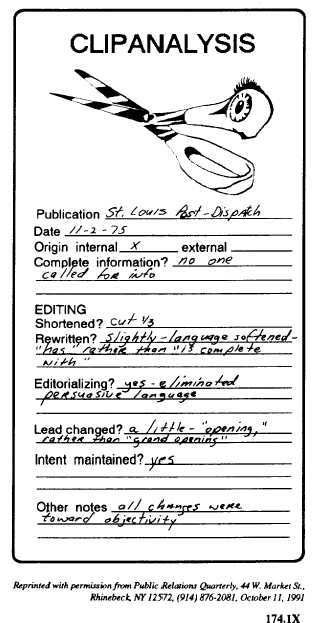. To be used as a historical source for future re-
search by your staff and visiting media repre-
sentatives.
. To provide a source for clips that maybe included
in the command history.
Your clip file should be a showcase for all who set
eyes on it. Do not settle for sloppily cut clips with jagged
edges and words missing, or clips that are stapled or
taped to its backing sheet. Make sure each clip is cut
from the source as straight as possible, and center mount
it on an 8 1/2-by 11-inch sheet of plain bond paper using
a paper adhesive, preferably rubber cement. Stapling or
taping the clip to the backing sheet will not give you a
professional product.
In either the upper left or upper right-hand corner of
the clip sheet, type the following information: (1) name
of the publication, (2) date of the publication and (3) the
page number in which the clip appeared. Make a
notation if the clip extended over more than one page.
Make a copy of each day’s clips to forward to the
CO, XO, C/MC and department heads for review. To
make sure the clips do not fall out of the folder, punch
two holes in the top of the mounting sheet of the clip and
attach them using a two-pronged fastener. Staple or
paper clip a route slip to the outside of the folder.
You may also want to analyze the clips that were
developed from an office external release. This can be
done by using a clip slip called “Clipanalysis.”
Public Relations Quarterly explains how the
CLIPANALYSIS system works.
Almost every time a public relations writer
sends off a news release, a number of questions
arise.
Will the publications use the release? Which
publications? Why wouldn’t it be used? Is it too
slanted? Have the editors grown tired of the subject
matter? If it is used, will it be edited, shortened,
corrected or will the intent be changed?
Puzzling questions? Of course, knowing the
editors helps in sorting out the dilemma. And
judicial media planning plays a part in clearing the
fog, but experience is the best teacher, as the saying
goes.
At PR&D, a creative marketing communica-
tions firm serving the St. Louis area, we have found
that the questions are becoming easier to handle,
thanks to our system for analyzing experience in
news release placement.
Simply put, the system provides for gathering
information on what editors use and do not use.
Then with the information in hand, releases are
prepared to mesh with editor’s requirements.
Here is how we do it: with a handy little form
called a Clip Slip.
When a clipping comes back to us, we study it
carefully–as anyone would–but we carry the
process a couple of steps further. Comparing the
clipping to the release we issued, we analyze
the differences by applying the puzzling
questions noted earlier. (See the sample Clip Slip in
figure 1-15.)
Figure 1-15.-Sample CLIPANALYSIS.
1-39


